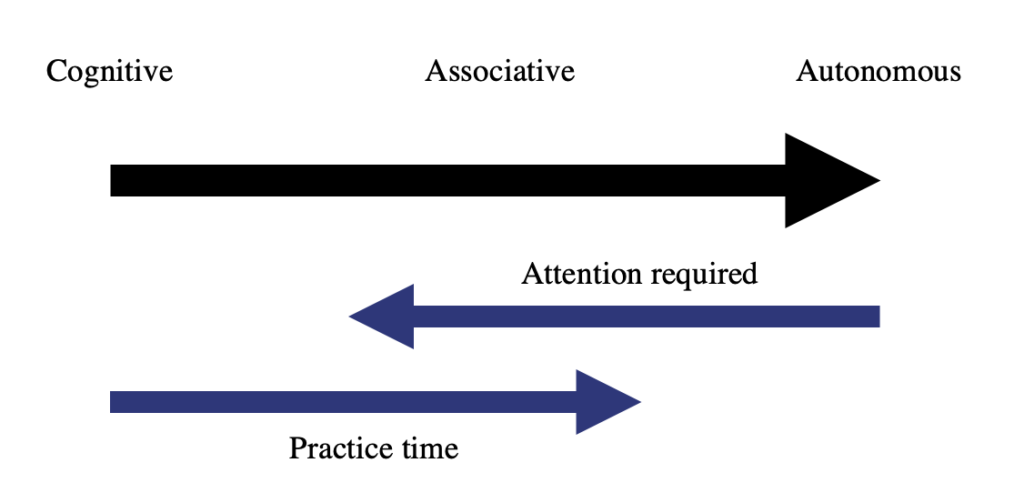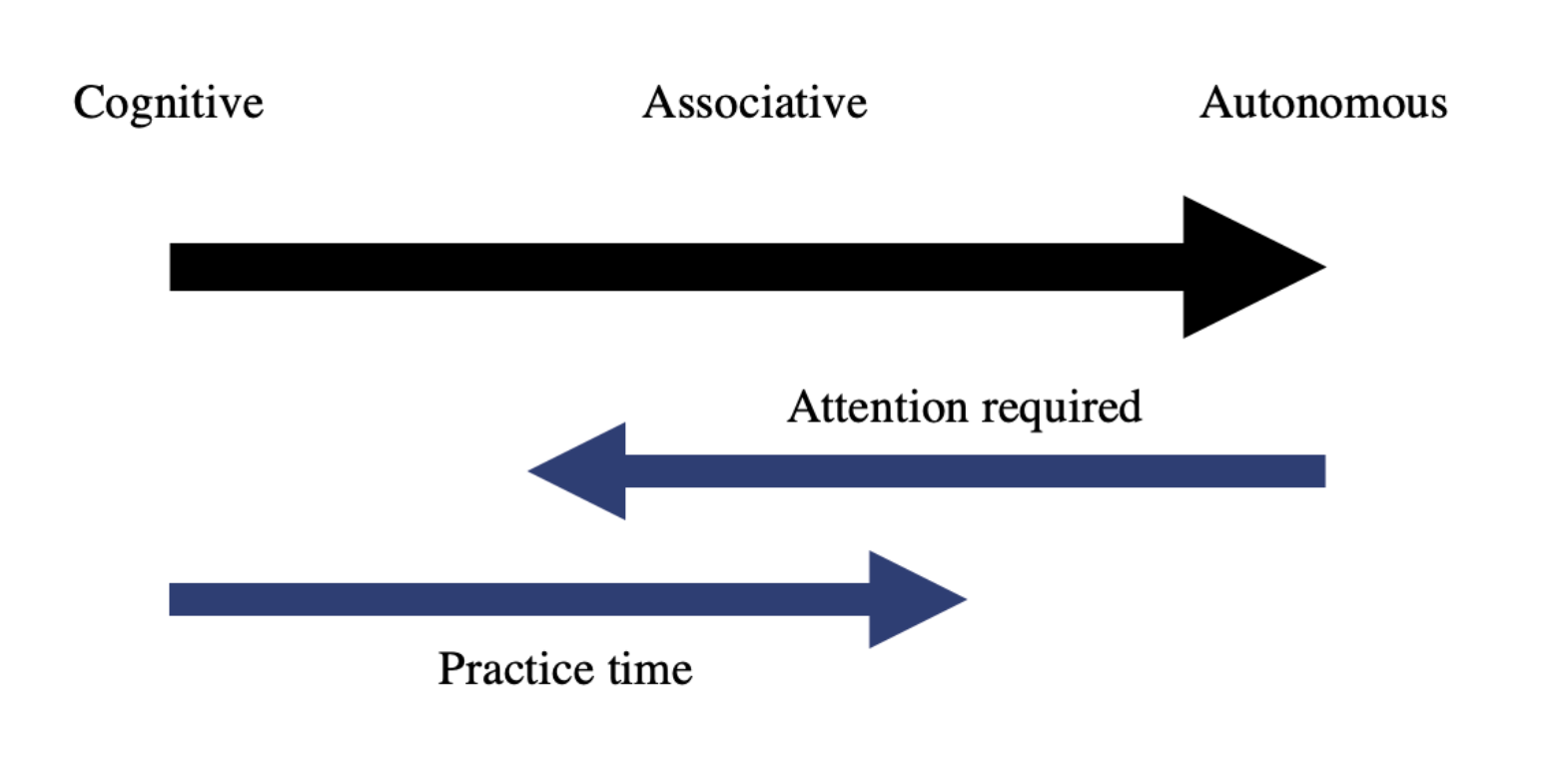Stages of learning consider the process of how a performer transitions from an unskilled novice to an expert for a given motor skill. This might be a child learning to catch a ball, a beginner learning to serve in Tennis, or a skill athlete transitioning from intermediate to advanced stages of learning.
As an athlete practices a skill we see a progression in their success and the movement pattern they use to perform the skill.
For example, when we observe a child throwing a ball, over time they can throw the ball further and their throwing action becomes more fluid. The stages of learning theory aims to explain the processes that underpin this progression in performance.
Fitts & Posner’s (1967) three stages of motor learning is the most well-known theory. Below we will summarise the key stages and concepts from Fitts and Ponser’s work and explain how this concept can be applied to your coaching.
The Fitts and Posner three-stage model
Fitts and Posner’s stages of learning theory considers the attentional demands when learning a new skill and the amount of practice time required to reach each stage. Although we often break the model down into three distinct phases, in practice, performers fluidly shift up the continuum. It is also possible for an athlete to regress down the stages too.
The 3 stages of learning
The three distinct phases of learning include 1) the cognitive stage, 2) the associate (also called intermediate) stage and 3) the autonomous stage. Below we will provide more detail on each stage.

Cognitive stage of learning
The first phase is called the cognitive stage, also known as the novice phase of learning. During this stage of learning the performer is trying to work out what to do. The theory suggests learners attempt to cognitively understand the requirements and parameters of movements.
Imagine we have an athlete learning to serve in Tennis. To begin with the novice has to concentrate very hard, attending to many, if not all aspects of the serve. The amount of information that are trying to process can see overwhelming:
- Hold do I hold the racket?
- Where should my feet be?
- How should I move my arms?
- How do I time the movement?
- Where am I hitting to?
The questions above highlight the self-talk that might be going on inside an athlete’s head when learning to serve. At this stage we expect performers to be inconsistent and make many mistakes. They will also be actively taking part in problem-solving and trying to make sense of the task.
The section above gives you a good idea why this stage is called the ‘cognitive stage of learning’. Cognitive – meaning mental process, knowing learning and understanding things.
Fortunately, improvements in performance are quite quick at this stage and performance gains can be made with less practice than at later stages of learning.
Associative/intermediate stage of learning
During the associative stage, the performer is learning how to perform the skill well and how to adapt the skill. At this stage, the performer is attempting to translate declarative knowledge into procedural knowledge. In other words, the performer is transforming what to do into how to do it.
There is less self-talk during the associate stage, and the athlete can perform chunks of the skill with less thought, but performing the movement as a whole still requires cognitive thought and problem-solving.
When entering the associative stage of learning our Tennis player would begin to extract cues from their environment. This might include where their opponent is positioned and the height of the net on their desired ball-target line. These cues are used to create the optimum movement (known as perception–action coupling).
Aspects of the ball toss and arm movement may be performed with less thought, but timing the sequence of these actions still requires attention and problem-solving. As a result, performance is better than in the cognitive stages of learning, but the performer still creates greater levels of variability in shot outcome compared to an expert performer.
This associate stage of learning can continue for varying periods of time, depending on the complexity of the task and volume of practice. Some performers may never progress past this stage if they do not invest heavily in skill development. Other elite performers (autonomous stage) may revisit the cognitive and associative stages to re-learn or refine their skill to reach higher levels of performance in the future.
Autonomous stage of learning
At the autonomous stage, the skill is almost automatic to produce and requires minimal thought. At this stage, athletes require less conscious control of movements and the actions produced often feel effortless (see internal model theory as to why this phenomenon occurs).
The reduced attentional demands at this stage allow the performer to focus more on perceptual cues, such as where their Tennis opponent is on the court.
At this stage, performers can also produce the movement alongside other demanding tasks, as their attentional capacity is no longer needed to control the action. For example where they need to move to after their serve to be prepared for the return shot.
Summarising Fitts and Posner’s 3 stages of motor learning
Motor learning [link to new article] is complex and can be considered from many perspectives. Fitts and Posner’s theory considers motor learning from an information-processing approach – that is they consider how the human body adapts and learns to process information during the learning process.
This approach is useful but does neglect other motor learning considerations. Such as the biomechanical changes we observe (see Bernstein’s theory), the changes in perception and visual cues (see Gibson’s theory) and neural substrates of motor learning (see Wolpert’s work.)
Why should I learn theories of motor learning?
Our job in sport science and coaching is to help athletes get better. Motor learning theory allows us to understand that process. Motor learning theories help us evaluate the athlete and support evidence-based practice to develop an athlete – see some of the examples below.
How can I use this as a coach/practitioner/athlete?
Fitts and Posner’s theory is a little outdated in fully explaining how the body controls movement. However, the basic concepts are still useful in practice.
When coaching beginners, you should be aware that performing the skill will take up most or all of their attention. They are trying to make sense of the task and how best to perform it.
At this stage, you should try to keep the skill basic, limit variations in the task and limit distractions from the environment. For example, when teaching a child to catch a ball, stay the same distance away, use a big, colourful ball and get rid of any distractions. These changes will reduce the amount of thinking and problem-solving required.
As the child improves and moves towards an associative/intermediate stage we can continue to use the framework to develop our practice. We could add variability to our practice and/or have two or three throwers that the child may need to pay attention to. These changes require additional attention, as there is more information to be processed.
The two examples above are very simple ways we can use Fitts and Ponser’s stages of learning theory to design effective practice environments.
Other theories of motor learning
If you are interested in learning more, check out dynamical systems theory, Bernstein’s degrees of freedom theory and Gentile’s ecological learning theory.
Frequently asked questions
Here are some frequently asked questions about Fitts and Ponser’s three stages of learning.
What are the three stages of motor learning?
The three stages of motor learning are cognitive, associate and autonomous. Learners generally progress through these stages in the order above. However, they can also get stuck or regress back into an earlier stage of learning.
Further reading
- Fitts, P. and Posner, M.I. (1967) Human Performance. Brooks/Cole Publishing, Belmont, CA.
- Huber, J. (2013) Applying Educational Psychology in Coaching Athletes
- Utley, A. (2018) Motor Control, Learning and Development: Instant Notes, 2nd Edition
Page Reference
If you quote information from this page in your work, then the reference for this page is:
- Shaw, W. (2020) The Three Stages of Learning. Available from: https://sportscienceinsider.com/stages-of-learning/ [Accessed dd/mm/yyyy]
Will is a sport scientist and golf professional who specialises in motor control and motor learning. Will lecturers part-time in motor control and biomechanics, runs Golf Insider UK and consults elite athletes who are interested in optimising their training and performance.

